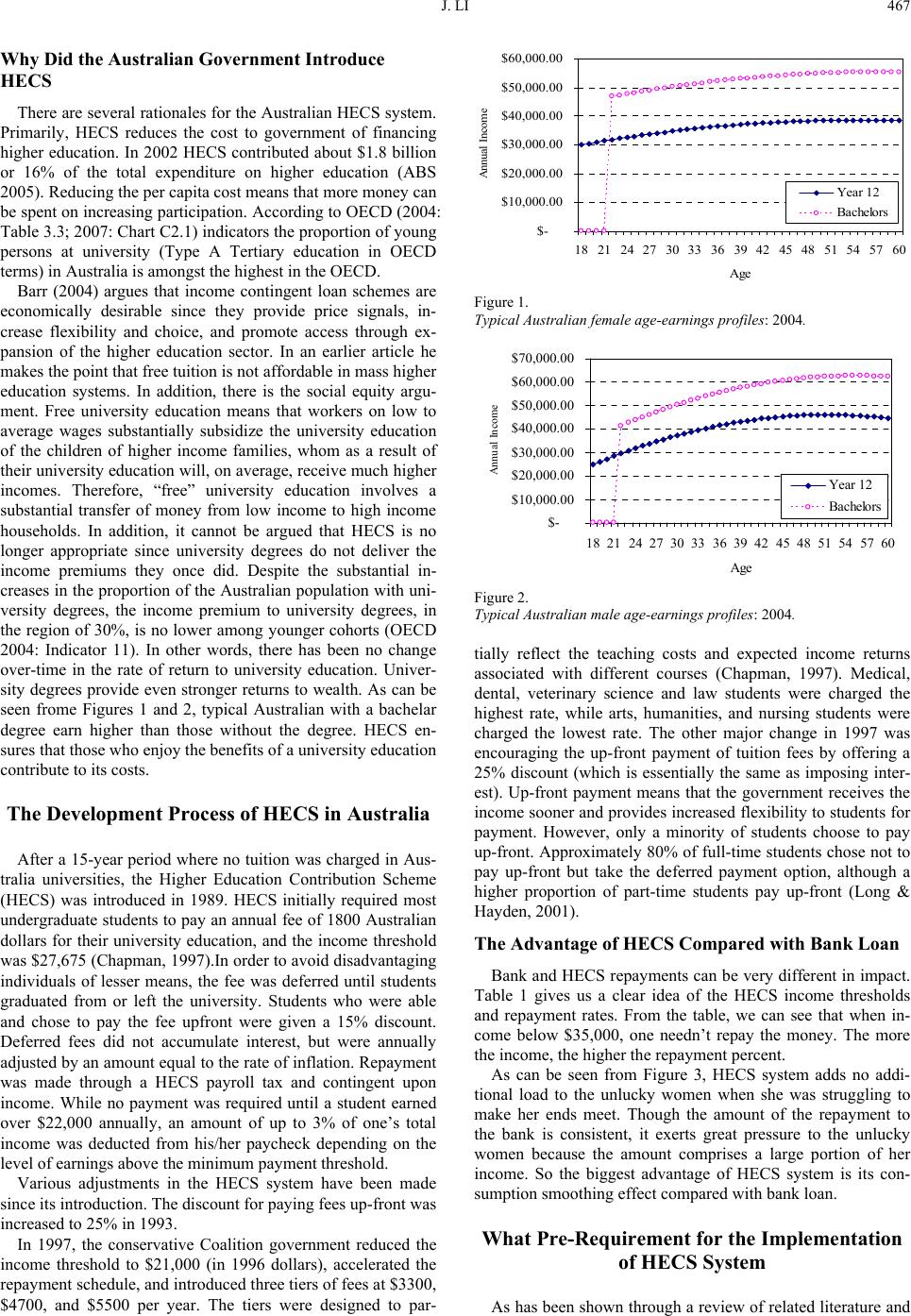
J. LI 467
Why Did the Australian Government Introduce
HECS
There are several rationales for the Australian HECS system.
Primarily, HECS reduces the cost to government of financing
higher education. In 2002 HECS contributed about $1.8 billion
or 16% of the total expenditure on higher education (ABS
2005). Reducing the per capita cost means that more money can
be spent on increasing participation. According to OECD (2004:
Table 3.3; 2007: Chart C2.1) indicators the proportion of young
persons at university (Type A Tertiary education in OECD
terms) in Australia is amongst the highest in the OECD.
Barr (2004) argues that income contingent loan schemes are
economically desirable since they provide price signals, in-
crease flexibility and choice, and promote access through ex-
pansion of the higher education sector. In an earlier article he
makes the point that free tuition is not affordable in mass higher
education systems. In addition, there is the social equity argu-
ment. Free university education means that workers on low to
average wages substantially subsidize the university education
of the children of higher income families, whom as a result of
their university education will, on average, receive much higher
incomes. Therefore, “free” university education involves a
substantial transfer of money from low income to high income
households. In addition, it cannot be argued that HECS is no
longer appropriate since university degrees do not deliver the
income premiums they once did. Despite the substantial in-
creases in the proportion of the Australian population with uni-
versity degrees, the income premium to university degrees, in
the region of 30%, is no lower among younger cohorts (OECD
2004: Indicator 11). In other words, there has been no change
over-time in the rate of return to university education. Univer-
sity degrees provide even stronger returns to wealth. As can be
seen frome Figures 1 and 2, typical Australian with a bachelar
degree earn higher than those without the degree. HECS en-
sures that those who enjoy the benefits of a university education
contribute to its costs.
The Development Process of HECS in Australia
After a 15-year period where no tuition was charged in Aus-
tralia universities, the Higher Education Contribution Scheme
(HECS) was introduced in 1989. HECS initially required most
undergraduate students to pay an annual fee of 1800 Australian
dollars for their university education, and the income threshold
was $27,675 (Chapman, 1997).In order to avoid disadvantaging
individuals of lesser means, the fee was deferred until students
graduated from or left the university. Students who were able
and chose to pay the fee upfront were given a 15% discount.
Deferred fees did not accumulate interest, but were annually
adjusted by an amount equal to the rate of inflation. Repayment
was made through a HECS payroll tax and contingent upon
income. While no payment was required until a student earned
over $22,000 annually, an amount of up to 3% of one’s total
income was deducted from his/her paycheck depending on the
level of earnings above the minimum payment threshold.
Various adjustments in the HECS system have been made
since its introduction. The discount for paying fees up-front was
increased to 25% in 1993.
In 1997, the conservative Coalition government reduced the
income threshold to $21,000 (in 1996 dollars), accelerated the
repayment schedule, and introduced three tiers of fees at $3300,
$4700, and $5500 per year. The tiers were designed to par-
$-
$10,000.00
$20,000.00
$30,000.00
$40,000.00
$50,000.00
$60,000.00
18 21 2427 3033 36 394245485154 57 60
Age
Annual Inco me
Year 12
Bachelors
Figure 1.
Typical Australian female age-earnings profiles: 2004.
$-
$10,000.00
$20,000.00
$30,000.00
$40,000.00
$50,000.00
$60,000.00
$70,000.00
18 21 24 2730 33 36 3942 45 4851545760
Age
Annual Income
Year 12
Bachelors
Figure 2.
Typical Australian male age-earnings profiles: 2004.
tially reflect the teaching costs and expected income returns
associated with different courses (Chapman, 1997). Medical,
dental, veterinary science and law students were charged the
highest rate, while arts, humanities, and nursing students were
charged the lowest rate. The other major change in 1997 was
encouraging the up-front payment of tuition fees by offering a
25% discount (which is essentially the same as imposing inter-
est). Up-front payment means that the government receives the
income sooner and provides increased flexibility to students for
payment. However, only a minority of students choose to pay
up-front. Approximately 80% of full-time students chose not to
pay up-front but take the deferred payment option, although a
higher proportion of part-time students pay up-front (Long &
Hayden, 2001).
The Advantage of HECS Compared with Bank Loan
Bank and HECS repayments can be very different in impact.
Table 1 gives us a clear idea of the HECS income thresholds
and repayment rates. From the table, we can see that when in-
come below $35,000, one needn’t repay the money. The more
the income, the higher the repayment percent.
As can be seen from Figure 3, HECS system adds no addi-
tional load to the unlucky women when she was struggling to
make her ends meet. Though the amount of the repayment to
the bank is consistent, it exerts great pressure to the unlucky
women because the amount comprises a large portion of her
income. So the biggest advantage of HECS system is its con-
sumption smoothing effect compared with bank loan.
What Pre-Requirement for the Implementation
of HECS System
As has been shown through a review of related literature and